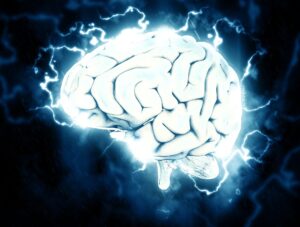Both migraines and endometriosis affect a high percentage of the population. Endometriosis affects about 10-15% of the population, while migraines affect >12% of the population (Parasar, Ozcan, & Terry, 2017; Yeh, Blizzard, & Taylor, 2018). So is any association between the two just an overlap of two common conditions? Or is there something that ties the two together? According to several studies (see below), there is a higher prevalence of migraines in people with endometriosis. One study (Yang et al., 2012) looked at the role of hormones in migraines and endometriosis, noting the common link between the two might be due to the hormonal influence on both. The study attempted to control the data “for age and frequently utilized hormone therapies” and found that there is a “co-morbid relationship between migraine and endometriosis, even after adjusting for the possible effects of female hormone therapies on migraine attacks” (Yang et al., 2012). One study noted that “adolescents with endometriosis are more likely to experience migraines than those without endometriosis” (Gałczyński et al, 2019).
Studies:
“Migraine prevalence in cases was significantly higher compared with controls (35.2% vs. 17.4%, p = 0.003). The risk of endometriosis was significantly higher in migrainous women (OR = 2.62; 95% CI = 1.43-4.79). When we take into account endometriosis phenotypes, the risk of ovarian endometrioma and deep infiltrating endometriosis were significant (OR = 2.78; 95% CI = 1.11-6.98 and OR = 2.51; 95% CI = 1.25-5.07, respectively). In women with endometriosis, the intensity of chronic non-cyclical pelvic pain was significantly greater for those with migraine (visual analogic scale (VAS) = 3.6 ± 2.9) compared with the women without headache (VAS = 2.3 ± 2.8, p = 0.0065).
Conclusion: Our study shows a significant association between migraine and endometriosis. In clinical practice, women of reproductive age who suffer from migraine should be screened for endometriosis criteria in order to optimise the medical and therapeutic care of this condition.”
“This study showed that the prevalence of migraine was significantly higher in patients with endometriosis. Because there is a strong correlation, patients with endometriosis should be screened for headache and migraine to increase the benefits of care.”
“There is high prevalence of both migraine and endometriosis; however, the association between both is controversial. This systematic review evaluated the association between endometriosis and the risk of migraine headache. A search was done of the following international electronic bibliographic databases including: PubMed, Web of Science, and Scopus to May 2020. Heterogeneity among studies was determined by Q-test and I2 statistic. Publication bias was assessed by Begg’s and Egger’s tests. The results were reported using the odds ratio (OR) estimate with its 95% confidence interval (CI) using a random-effects model. The search identified 802 articles with 287,174 participants. There was a significant association between endometriosis and the risk of migraine headache (OR = 1.56; 95% CI: 1.21, 1.90). Based on the Newcastle Ottawa Statement Manual (NOS) scale, all studies had high quality. The findings showed that endometriosis was significantly associated with an increased risk of migraine headache. Future research should be focused on measures that could help to reduce the risk of migraine headache among women with endometriosis.”
“Adolescents with endometriosis are more likely to experience migraines than adolescents without endometriosis. A linear relationship exists between migraine pain severity and the odds of endometriosis, suggesting heightened pain sensitivity for adolescents with endometriosis. Due to the strong correlation, patients who present with either condition should be screened for comorbidity to maximize the benefits of care.”
“Previous research suggests that a co-morbid relationship exists between migraine and endometriosis; however, results have been inconsistent. In addition, female hormones, which are important in the pathogenesis and management of endometriosis, have been reported to precipitate migraine attacks and may confound the results. The aim of this population-based cohort study was to explore the relationship between migraine and endometriosis in women of reproductive age (18–51 years). Data were derived from the National Health Insurance Research Database of Taiwan, which contains outpatient and inpatient records from 2000 to 2007. Our study cohort included 20,220 endometriosis patients and 263,767 controls without endometriosis. We analyzed the prevalence of migraine in these women as recorded during the eight years of the database. Our results found that patients with endometriosis were more likely to suffer migraine headaches compared to controls (odds ratio [OR], 1.70; 95% confidence interval [CI] [1.59, 1.82]; p<0.001). In addition, the co-morbid association between migraine and endometriosis remained significant after the data were controlled for age and frequently utilized hormone therapies (OR, 1.37; 95% CI, [1.27, 1.47]; p<0.001). The results of this cohort study support the existence of a co-morbid relationship between migraine and endometriosis, even after adjusting for the possible effects of female hormone therapies on migraine attacks.”
References
Gałczyński, K., Jóźwik, M., Lewkowicz, D., Semczuk-Sikora, A., & Semczuk, A. (2019). Ovarian endometrioma–a possible finding in adolescent girls and young women: a mini-review. Journal of ovarian research, 12(1), 1-8. Retrieved from https://ovarianresearch.biomedcentral.com/articles/10.1186/s13048-019-0582-5
Parasar, P., Ozcan, P., & Terry, K. L. (2017). Endometriosis: epidemiology, diagnosis and clinical management. Current obstetrics and gynecology reports, 6(1), 34-41. Retrieved from https://www.ncbi.nlm.nih.gov/pmc/articles/PMC5737931/
Yeh, W. Z., Blizzard, L., & Taylor, B. V. (2018). What is the actual prevalence of migraine?. Brain and behavior, 8(6), e00950. Retrieved from https://www.ncbi.nlm.nih.gov/pmc/articles/PMC5991594/
